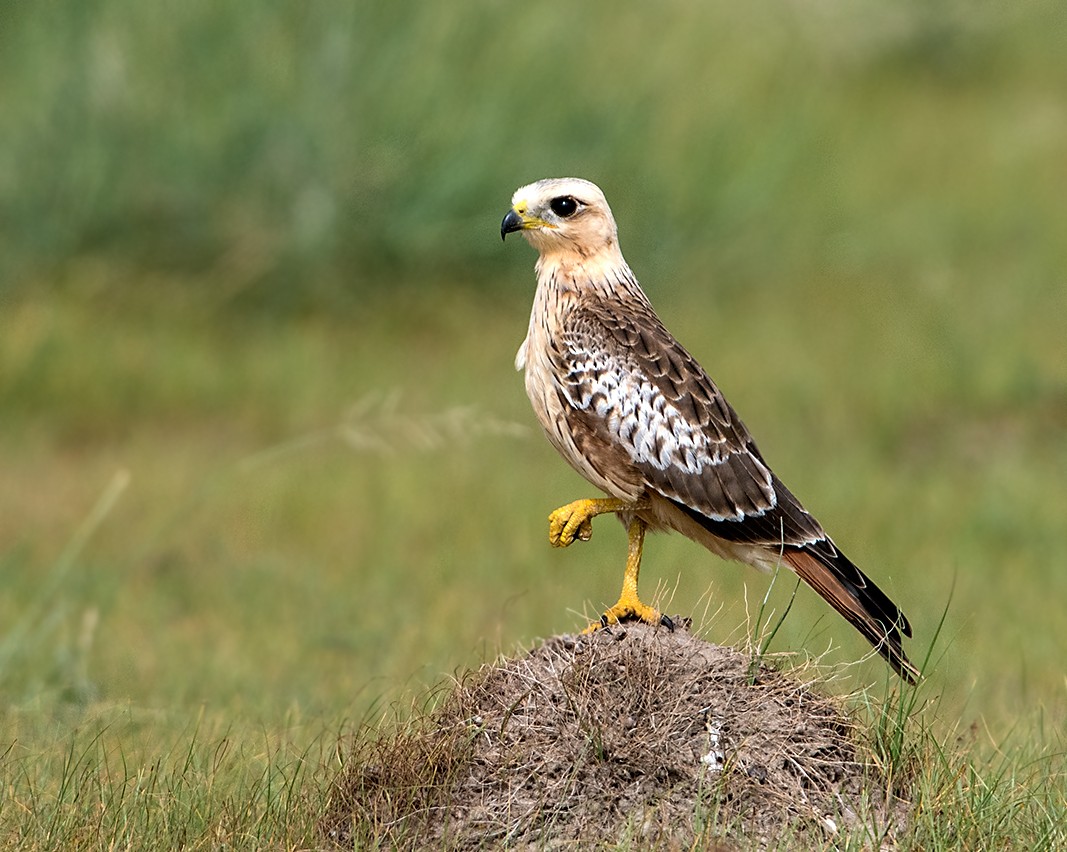White-eyed Buzzard
A species of Butastur Buzzards Scientific name : Butastur teesa Genus : Butastur Buzzards
White-eyed Buzzard, A species of Butastur Buzzards
Botanical name: Butastur teesa
Genus: Butastur Buzzards
Content
Description General Info
Description
This slim and small hawk is easily identified by its white iris and the white throat and dark mesial stripe. A white spot is sometimes visible on the back of the head. When perched, the wing tip nearly reaches the tip of the tail. The ceres are distinctly yellow and the head is dark with the underside of the body darkly barred. In flight, the narrow wings appear rounded with black tips to the feathers and the wing lining appears dark. The upper wing in flight shows a pale bar over the brown. The rufous tail is barred with a darker subterminal band. Young birds have the iris brownish and the forehead is whitish and a broad supercilium may be present. The only confusion can occur in places where it overlaps with the grey-faced buzzard (Butastur indicus), adults of which have a distinctive white supercilium. Fledgelings are reddish brown, unlike most other downy raptor chicks, which tend to be white. 
Size
43 cm
Colors
Brown
Red
Gold
Bronze
White
Nest Placement
Tree
Feeding Habits
White-eyed Buzzard predominantly consumes large insects, including locusts, grasshoppers, and crickets. Their diet also features small mammals like mice, reptiles, amphibians, and occasionally crabs. White-eyed Buzzard may prey on larger animals, such as black-naped hares, showcasing opportunistic feeding behavior.
Habitat
White-eyed Buzzard typically dwells in dry, open territories characterized by sparse forests and agriculturally developed areas. These birds are comfortable in lowland regions but are also known to ascend to elevations of up to 1200 meters in the Himalayan foothills, occasionally venturing as high as 2000 meters during summer months. Although they mainly reside below 500 meters, there have been exceptional sightings of white-eyed Buzzard at heights of up to 4000 meters. Geographically, it inhabits broad expanses of South Asia.
Dite type
Carnivorous
General Info
Feeding Habits
Bird food type
Behavior
This species is usually seen soaring alone in thermals or perched still. Groups of two or three may sometimes be seen. They have a mewing call or falling whistle (transcribed as pit-weer) that is repeated when pairs are soaring. They are vociferous in the breeding season. They feed mainly on locusts, grasshoppers, crickets, and other large insects, as well as mice, lizards, and frogs. They may also take crabs from near wetlands and have been reported to take larger prey such as the black-naped hare (Lepus nigricollis). The breeding season is February to May. The nest is loose platform of twigs not unlike that of a crow, sometimes placed in a leafless tree. The usual clutch is three eggs, which are white and usually unspotted. Both sexes share nest-building and feeding young; the female alone incubates for about 19 days until the eggs hatch. A species of endoparasitic platyhelminth has been described from the liver of this species. A species of nematode, Contracaecum milvi, has been recorded in the liver and the stomach while Acanthocephalans, Mediorhynchus gibson and M. fatimae, has been described from the gut of specimens from Pakistan. Protozoa that live in the blood stream belonging to the genus Atoxoplasma have been isolated. Like most birds, they have specialized ectoparasitic bird lice such as Colpocephalum zerafae that are also known from other birds of prey. A study of power lines in Rajasthan in 2011 found white-eyed buzzards to be the second most common raptor killed by electrocution after kestrels. 
Distribution Area
This species is widely distributed in South Asia, throughout India in the plains and extending up to 1000 m in the Himalayas. It is a resident in Iran, Pakistan, Nepal, Bangladesh, and Myanmar. A form that is possibly of this species has been recorded in the Greater Sundas, Indonesia but this population is widely disjunct and has whiter and unmarked feathers on the thigh or "trousers" and vent, possibly representing a new form. It is absent from Sri Lanka and is probably absent from the Andamans. It is a summer visitor in northeastern Afghanistan. It is mainly found in the plains, but may go up to 1200 m altitude in the foothills of the Himalayas. The usual habitat is in dry, open forest or cultivation. They are numerous in some areas, but declining. A survey in the late 1950s estimated about 5000 birds in the vicinity of Delhi in an area of about 50,000 km giving a density of 0.1 per square kilometre. 
Species Status
Not globally threatened.
